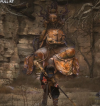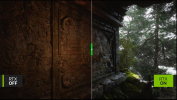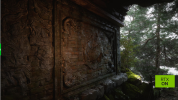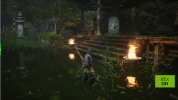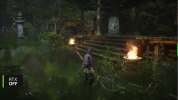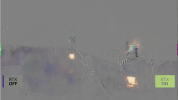Sigh... I really hesitate to wade back into this but given people are directly attributing quotes to me I will at least try and clarify those bits.
The game doesn't even make use of VSM as well because testing the clipmaps against large primitives would involve high overhead due to reduced culling efficiency ...
I would have assumed this as well, with non-Nanite terrain being a big issue usually as well. That said, you can enable VSMs in the ini files and it is only very slightly slower than the shadow map path and so far I haven't seen any artifacts that aren't related to some foliage LOD/shadow proxy thing they have going on and thus are the same in the regular SM path as well. I really don't know why they didn't provide them as an option, as they bring the visuals a lot closer to the RT path with a much smaller performance hit.
I will wait the final judgment on that, that very same RenderDoc gave a false result for Lumen.
Ok, the initial test was not invalid because of RenderDoc or the person who did it - it's because the game is buggy with settings changes sometimes so when he took the capture it literally was running without Lumen (i.e. GI "low"). This is interesting to note because it now seems highly probably related to...
As for Path Tracing and Nanite, I think we can all agree that the results shown so far are anything but bad.
Yeah so... there are spots where it looks good, but the irony is the ones you kept pointing out in other threads from online videos are not them. In fact, given the above I've now connected some dots in my head and I'm actually pretty certain that those examples where people keep pointing out "oh it's so much brighter with RT" (but it looks totally flat) are actually bugged settings - probably the same bug the original RenderDoc capture hit - and you could probably get the same result by forcing off GI (with either RT setting). I have tried to be polite, but honestly if you look at those images and think that they are great looking lighting/PT then I question your ability to judge what looks good in the first place. Nothing smells brand loyal/fanboy nonsense more than literally looking at a constant ambient term but promoting the difference as the best thing in the world because someone told you it was path tracing.
Yes they’re likely using screen space techniques to fill holes. Not sure what’s so damming about that or how it diminishes the benefits of PT. Are you suggesting that path tracing implementations must be perfect in order to show progress? 3D rendering is full of hacks and always has been.
Yes of course they use screen space traces to deal with the lower res RT meshes, for all types of raytracing. This is completely normal and expected and not something to get upset over. That said, it's just as silly to get upset over screen space traces in Lumen. Particularly since the screen space tracing code they use in the RTX branch is literally lifted from/exactly the same as the Lumen trace code.
Obviously triangle RT is generally higher quality than SDF RT, but Lumen can of course do both. Implying that Lumen can only do screen space reflections and/or SDFs is silliness - that's a performance tradeoff that games decide. Which brings to the next point...
Andrew raised some concerns about GI quality. Haven’t seen any complaints about the shadow quality. He mentioned RT shadows were static but that doesn’t seem accurate based on released footage.
See above for "GI quality". Shadows look totally fine in the final game to me. The caustics are neat and I like them. The main concession is of course...
The performance is reasonable and is mostly inline with other path traced titles that don't rely on virtualized geometry.
"In line" or not, it really needs to be emphasized that it's way slower. Like
really barely usable on a 4090 really fucking slow. Like even me with my 4090 who loves pretty graphics and hates bad shadows will not play it at those frame rates. I don't know why we keep circling around on these same things to be honest... the more approximate techniques are faster, the more accurate ones are slower. It's a
good thing to have options all across the curve. It's probably still going to be a long time before a AAA game could ship with only a RT path the cost of Wukong's, especially considering consoles. It's great that I can maybe play with RT on a 5090 or whatever in the future, but let's not pretend that the two paths are comparable at all in terms of performance.
They locked in on 5.0 to get the game out as soon as possible. I get it, the game has a massive amount of content that would need to be retested-redone.
I'm still skeptical that this is actually 5.0. Is this based on anything other than binary metadata yet? Someone could probably get a better estimate by trying some cvars that were added in 5.1, 5.2, etc. and seeing which are present. I think some of the Unreal tools that enable the console or similar could probably dump the full list for cross referencing. Or you know, someone could ask the developers


